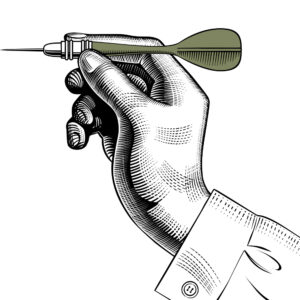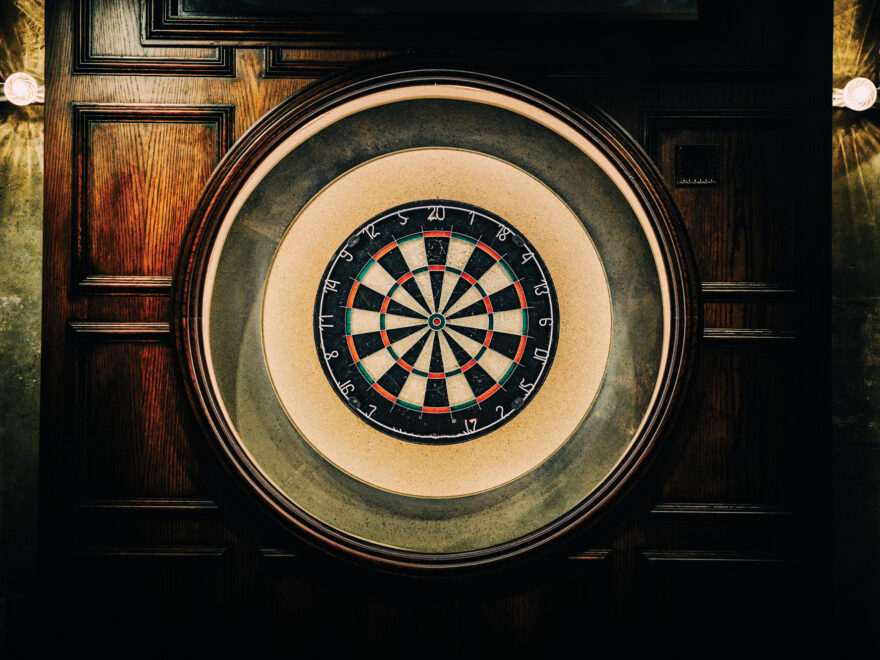When you first look at a dartboard the thing that confuses most people is why the numbers are set out the way they are. The answer is similar to the reason that the keys on a keyboard are not in alphabetical order. 
There are various theories about why the letters on a keyboard are mixed as they are, the most common (not necessarily correct) being that the original mechanical action of the typewriter type bars was likely to jam if too many keys were typed too quickly while being too close to each other, so it was designed to slow down typists. The QWERTY keyboard was patented in 1878, but by 1893 it was the accepted standard, and has never been successfully challenged.
In the early days as the dartboard evolved a few layout options were offered, though the sequence of numbers commonly seen in international competition has been the accepted standard since the National Darts Association was formed in London in 1925. Early dartboards had only 12 segments with scores being multiples of 5, until in 1913 the 20 segments appeared, but originally with no treble ring and only a single bullseye. This evolved into the board we see today with the addition of the treble ring and outer bull.
Sadly there is no definitive source explaining how the number sequence came about, though there have been many theories as to why it makes sense. The official line of thought is they were placed in such a way as to encourage accuracy, as you will notice most of the larger numbers are flanked by smaller ones, so if you miss when you aim for a big number you are unlikely to be “lucky” enough to hit another big number. They don’t necessarily follow a pattern and alternatives have been suggested, but just as the keyboard letter sequence became a standard because so many had used it for so long that it became too hard to change, the dartboard number sequence has been standardised as it is for nearly a century.
There was a short period when the standard game could have changed dramatically with the introduction of a “quad” ring which was added between the triple ring and bullseye, scoring quadruple points. Even though Harrows made a short production run of this board (1992 – 2000) and it was used in the WDC UK Matchplay from 1993 – 1996 it didn’t catch on and has not been used in a professional event since. They have become quite a collectors item though, so grab it if you happen across one for sale somewhere, so far none of the manufacturers have been interested in resurrecting them.
As for the construction of the board the first boards were made from log ends of elm which needed soaking daily to soften them, or plasticine which needed to be smoothed after each leg with a warm iron which caused a terrible smell. The original bristle boards were marketed by the Nodor Company in 1935, the name of which came from the words No Odor from the invention in 1919 of plasticine that didn’t smell. Nodor first marketed the (not so smelly) plasticine dartboard in 1923 and the idea of a bristle board came about in 1932 made from rope ends. Since then sisal has been the fibre of choice for dartboard construction, with 3.7 million fibres compressed tightly into a flat round disc before being sanded and screen printed. Sisal comes from agave leaves, the same plant that is used to make Tequila, though you won’t get drunk by sucking on a dartboard. Between dartboards, rope, Tequila, and it’s sweet syrup the agave plant has become quite popular to farm.
You’ll probably recognise a few names on dartboards if you watch darts on TV or frequent the various social drinking establishments. Common names are Harrows, Unicorn, Shot, Puma and Winmau (pronounced “win more”). The name Winmau was derived from the name of the founders wife, Winifred Maud Kicks. Harry Kicks started out making elm dartboards in 1945 until the technology arrived to make paper coil boards in the ‘50s. When the Nodor patent expired in the early ‘60s Kicks started making bristle boards and the quality was such that the British Darts Organisation (BDO) signed up the Kicks dartboards in 1973 to be the official boards of the organisation. A few years later the name changed to Winmau, and in 2002 Nodor bought out the brand. Nodor still produces top quality boards under the Winmau name and signed a 5 year deal in 2022 with the Professional Darts Corporation (PDC) to supply boards for all their tournaments.

